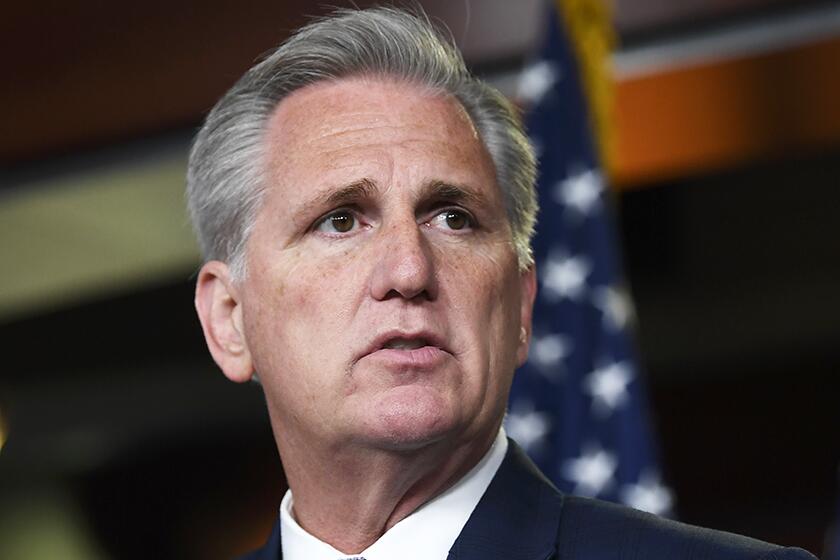Column: Anti-poverty programs work. Why are Democrats letting them wither?

- Share via
It’s an article of faith down our way that Democrats are good at enacting programs that help ordinary Americans and the vulnerable but are atrocious at communicating their ideals and successes to the public, while Republicans care only about serving the rich but are superb at fostering the misimpression that they’re servants of the masses.
This leaves the question: What happens when Democrats abandon their principles and leave ordinary Americans in the gutter?
The issue is relevant because that’s what is happening right this moment. Starting last year and culminating this month, three important elements of the social safety net have been or are being cut back: Medicaid, food stamps (formally the Supplemental Nutrition Assistance Program, or SNAP) and the Child Tax Credit.
The Child Tax Credit drove down poverty to levels we have never seen in the United States.
— Sharon Parrott, Center on Budget and Policy Priorities
Three things are true about all those programs. They’re hugely popular, they’re extraordinarily effective at fighting poverty, and they’ve been targets of Republican budget-cutters virtually as long as they’ve existed.
Under the circumstances, that should have placed these programs at the top of the “must do” list for the Biden White House and congressional Democrats. The Democrats, however, showed scant interest in imparting their importance to the GOP and conservative holdouts in their own party, such as Sen. Joe Manchin III (D-W.Va.).
Get the latest from Michael Hiltzik
Commentary on economics and more from a Pulitzer Prize winner.
You may occasionally receive promotional content from the Los Angeles Times.
As a result, the enhancements to the programs enacted during the pandemic were permitted to wither away. That happened despite reams of evidence of their effect on poverty rates, which justified continuing the augmentation past the immediate pandemic emergency and into the future.
Biden has made clear that he supports these programs. In his proposed budget for fiscal 2024, which was released Thursday, he called for restoring the Child Tax Credit to the levels that expired at the end of 2021.
That would mean raising the credit from the current $2,000 per child to $3,000 (and $3,600 for children 5 and younger) and making it fully refundable, so that it would be paid even if it exceeds a family’s tax liability.
Biden has also signaled a rare willingness to reverse years of tax policies indulging the rich.
His proposed tax increases are aimed at millionaires, billionaires and Big Business — among them an increase in the corporate tax rate to 28% from 21%, a minimum tax on billionaires and an increase in the top marginal rate to 39.6% on incomes of more than $400,000 (up from 35% on incomes of $462,500 for couples and 37% for those collecting $578,125 or more), and doubling the capital gains tax rate to 39.6% for those earning more than $1 million.
The Wall Street Journal says America ‘soaks the affluent.’ Try to hold back your tears.
Some of those increases would reverse the 2017 Republican tax cuts, which heavily favored corporations and the wealthy.
What’s lacking in America’s approach to the social safety net is any appreciation of how threadbare it is under normal circumstances. The success of pandemic-era emergency increases underscores that failing.
“The kind of assistance we give families leaves them in a very precarious financial circumstance,” says Sharon Parrott, president of the Center on Budget and Policy Priorities, a progressive think tank. “We don’t give people enough benefits even for them to meet their basic needs.”
An inability to put muscle into supporting their signature programs has been a chronic Democratic infirmity for decades. Sometimes it’s just a manifestation of cowardice — a fear that the public will punish them for spending on social problems.
In fact, the opposite has always been true; that’s the lesson taught by what happened after passage of the Affordable Care Act in March 2010. The Democrats allowed the GOP to define the program for the public as something nefarious, failed to stand up for its manifold virtues — and got slaughtered in that year’s midterm elections, losing six Senate and 63 House seats.
What’s the upshot? Enrollment in ACA exchange plans reached a record 15.9 million as of January, an increase of 13% over last year.
Two more states, South Dakota and North Carolina, are moving to expand Medicaid under the ACA. That leaves only 10 in which Republican governors or legislatures are still too stupid and ideology-addled to take advantage of the federal funding that comes with expansion and helps millions of their residents while shoring up the budgets of their rural hospitals.
Republicans say Biden is lying about their intention to cut Social Security and Medicare. The evidence backs him up.
Few Democrats have shown the willingness or skill to stand up against their opponents. The best was Franklin D. Roosevelt, who delighted in making sport of GOP animus, never letting voters forget what was at stake for them in every election. “I welcome their hatred,” he said resoundingly during his 1936 reelection campaign against Alf Landon of Kansas.
When Landon enlisted Big Business to support his campaign, which was centered on an attack on Social Security, by inserting critical fliers into workers’ pay envelopes, FDR blasted back: “Only desperate men with their backs to the wall would descend so far below the level of decent citizenship as to foster the current pay-envelope campaign against America’s working people.” He beat Landon in a landslide.
Biden, like Roosevelt, has made a point of defending Social Security against Republican meddling. But by extracting a pledge from the GOP during his State of the Union address last month to leave that program and Medicare alone, he may have left Medicaid exposed to Republican scalpels.
The GOP hasn’t concealed its goal of hobbling Medicaid, which provides health coverage to 80 million low-income Americans, making it the nation’s largest healthcare program. Republicans absolutely hate Medicaid.
As long ago as 2012, they were proposing to change Medicaid to a block-granted program — that is, changing its open-ended federal-state funding to a fixed annual sum. As I explained the last time this idea came up, this would destroy the program’s flexibility to respond to unexpected changes in healthcare needs either on the state or national level — changes such as, say, the emergence of the COVID-19 pandemic.
More recently, the proposed fiscal 2023 budget issued by the Republican Study Committee, a key GOP policy shop, took aim at Medicaid with a series of unsupported slanders.
The RSC claimed that it “continues to fail beneficiaries.” The drafters based this assertion partly on a tendentious and cherry-picked misreading of a study of Oregon Medicaid enrollees published in 2012.
That paper found that “Medicaid increased healthcare utilization, reduced financial strain and reduced depression” among its beneficiaries — which sound like unalloyed successes, not failures; depression, for example, is a major cause of disability in the United States.
The RSC also said that Medicaid reports an “improper payment rate” of 21.79% and implied that the figure translates into $80 billion worth of fraud annually. But its own source for the figure, a government audit site, makes clear that it’s nothing of the kind. Almost all the “improper” payments are the result of paperwork issues; the amount of “confirmed fraud” is zero.
The debt ceiling, being wielded by the ignorant children of the House GOP, is the stupidest feature of federal fiscal policy.
This year, a pandemic-related regulation known as the continuous enrollment provision is expiring. The rule required states to keep people enrolled in Medicaid through the end of the federal health emergency period in return for enhanced federal Medicaid funding. The emergency period will end in May.
States are already moving to restore their pre-pandemic Medicaid renewal process, which includes income tests. It’s expected that the result will be the disenrollment of 5 million to 14 million people, the Kaiser Family Foundation estimates.
It’s generally agreed that the continuous enrollment protection had to end at some point, says Jennifer Tolbert, the foundation’s director of state health reform. “There are people on the program who are clearly no longer eligible,” mostly because their incomes have risen beyond the eligibility point or they have found other coverage, Tolbert told me.
But the government estimates that 6.8 million people may lose their coverage despite still being eligible — possibly because they’ve moved or otherwise can’t be reached by enrollment officials.
The government says about 383,000 will fall into the “coverage gap” in states that haven’t expanded Medicaid — incomes too high for them to enroll in traditional Medicaid in their states but too low to qualify for premium assistance from the ACA (the Kaiser Family Foundation estimates that 2.1 million Americans are still in the coverage gap).
“Those are the people we’re most concerned about,” Tolbert said, “because they don’t have anywhere to go to get coverage.”
As for SNAP, Republicans never sheathe the knives they have out for the food stamp program. That outstanding hypocrite Rep. Doug LaMalfa (R-Richvale) declared during a debate on the program in 2013 that food stamps were the product of an “oppressive” federal government.
Republicans get away with flying migrants in a political stunt and voting against disaster aid, only because they know others will cover for the cruelty of their policies.
Helping the poor was better left to individuals and churches, he said at the time, because then “it comes from the heart, not from a badge or from a mandate.” Up to then, LaMalfa and his family farm had collected $5.1 million in federal crop subsidies.
As of March 1, food stamp benefits were slashed in 32 states, including California and Texas, which have the largest SNAP enrollments. The cuts had already been implemented in the other 18 states, which are generally Republican-controlled.
The cuts resulted from the end of emergency allotments — increased benefits launched early in the pandemic, when families faced huge economic disruptions. More than 30 million people are affected by the change. The cuts will average about $328 a month for a family of four. The average individual cut will come to $90 a month, leaving only about $6.10 per person per day.
The Child Tax Credit may be the starkest case of a program orphaned despite its inescapable value. Its expansion as part of the American Rescue Plan, the $1.9-trillion pandemic relief package Biden signed in March 2021, benefited more than 61 million children in more than 36 million households. The child poverty rate fell from 21.4% in August 2020 to 7.6% in March 2021.
“The Child Tax Credit drove down poverty to levels we have never seen in the United States,” Parrott told me. When the enhanced benefits expired in 2022, poverty rates across the board jumped back up, with the child poverty rate reaching 17.6% in June 2022. Restoring the credit had bipartisan support, but not enough to get it past the finish line in negotiations over Biden’s Inflation Reduction Act last year.
With the expiration of enhanced SNAP benefits and reductions in the Child Tax Credit, millions of Americans are facing poverty again. Biden’s budget would throw many of them a life preserver, but that won’t happen unless Democrats hammer Republicans with the consequences of their cheeseparing ways by reminding all voters what’s at stake.
More to Read
Get the latest from Michael Hiltzik
Commentary on economics and more from a Pulitzer Prize winner.
You may occasionally receive promotional content from the Los Angeles Times.















